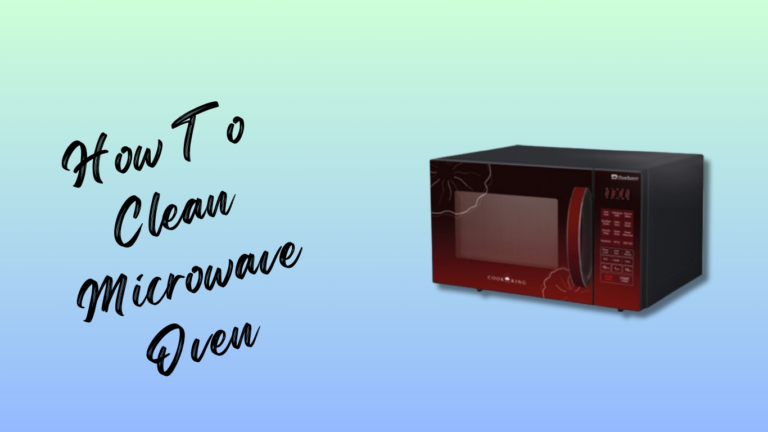Introduction
Keeping your microwave oven clean isn’t just about looks—it’s essential for food safety, energy efficiency, and appliance longevity. In 2025, with more people cooking at home, regular microwave cleaning prevents bacteria, mold, and fire risks. A dirty microwave can reduce heating performance, trap odors, and even cause electrical issues. This step-by-step guide shows how to clean your microwave using natural ingredients like vinegar, lemon, and baking soda—safely and effectively.
Why You Should Clean Your Microwave Regularly
Ensure food safety by removing bacteria, mold, and grease. Contaminated surfaces spread pathogens, affecting hygiene. Food residue absorbs moisture, leading to mold growth. Grease traps odors, altering the taste of new meals. Built-up spills interfere with heat distribution, lowering efficiency. Clean interiors prevent overheating and fire risks.
Essential Tools and Supplies Needed
- Mild Dish Soap & Warm Water – Remove grease and loosen food particles.
- Baking Soda & Vinegar – Dissolve stubborn stains and neutralize odors.
- Lemon & Water – Break down residue and eliminate bad smells.
- Microfiber Cloth & Sponge – Absorb moisture and prevent surface scratches.
How to Clean Your Microwave in 2025: Step-by-Step Instructions
1. Cleaning the Inside of the Microwave
- Use Vinegar & Water Steam – Mix equal parts vinegar and water in a microwave-safe bowl. Heat for 5 minutes to loosen grime.
- Scrub Stubborn Stains – Apply a baking soda paste to tough spots. Let sit for 5 minutes, then wipe with a damp sponge.
- Remove & Wash the Turntable – Take out the glass turntable and wash it with dish soap. Dry completely before placing it back.
2. Cleaning the Microwave Door and Exterior
- Wipe Down the Control Panel – Use a damp microfiber cloth with mild soap. Avoid excessive moisture near buttons.
- Clean Greasy Surfaces – Apply dish soap to a soft sponge. Gently scrub the exterior to remove grease and fingerprints.
- Polish with a Microfiber Cloth – Dry the microwave with a microfiber cloth to remove streaks and enhance shine.
Remove Tough Microwave Stains and Odors Naturally
- Use Lemon Steam for Deodorizing – Heat a bowl of water with lemon slices for 5 minutes. The steam loosens grime and eliminates odors.
- Apply Baking Soda Paste for Stains – Mix baking soda with water to form a paste. Spread on stains, let sit for 10 minutes, then wipe clean.
- Absorb Odors with Activated Charcoal or Coffee – Place activated charcoal or dry coffee grounds inside. Leave overnight to neutralize smells.
Microwave Maintenance in 2025: Tips to Prevent Damage
- Avoid Metal and Foil Inside – Keep metal objects and aluminum foil out. They cause sparks and damage internal components.
- Cover Food to Prevent Splatters – Use microwave-safe covers or lids. This reduces mess and prevents food buildup inside.
- Check and Replace Faulty Parts – Inspect door seals, turntable, and internal lights. Replace damaged parts to maintain efficiency.
- Ensure Proper Ventilation and Placement – Place the microwave on a stable surface with airflow. Keep vents clear to prevent overheating.
Common Mistakes to Avoid When Cleaning Your Microwave
Using harsh chemicals weakens the microwave’s interior coating. Ammonia and bleach-based cleaners cause discoloration and damage. Scrubbing too hard on the control panel affects button functionality. Excessive force removes labels and disrupts the touchpad. Forgetting to clean vents and filters reduces airflow. Blocked ventilation causes overheating and affects efficiency. Ensuring proper maintenance extends microwave lifespan and performance.
Conclusion
Regular cleaning and maintenance improve microwave performance. Using vinegar steam and baking soda removes stains and odors. Wiping the control panel and vents prevents buildup and overheating. Covering food reduces splatters and keeps the interior clean. Checking and replacing faulty parts ensures long-term efficiency. Proper care extends lifespan and maintains optimal heating power.
Frequently Asked Questions ( FAQs )
How often should I clean my microwave?
You should wipe down your microwave once a week. Do a deep clean once a month to keep it fresh and working well.
What is the safest way to remove stains?
Use a paste made from baking soda and water. Let it sit on the stain for a few minutes, then wipe it off with a damp cloth.
Can I use bleach to clean my microwave?
No. Bleach is too harsh and can damage the inside of the microwave. Use natural cleaners like vinegar or lemon instead.
How do I get rid of bad smells in the microwave?
Heat a bowl of water with lemon slices or vinegar for a few minutes. You can also leave dry coffee grounds or charcoal inside overnight to absorb odors.
Is it safe to clean the microwave control panel with water?
Yes, but be careful. Use a damp cloth with a little dish soap and gently wipe the panel. Avoid getting water near the buttons or openings.
Why is my microwave not heating properly after cleaning?
Make sure nothing is blocking the vents. Check if the turntable is in place and the door closes properly. Damaged parts may need replacing.

